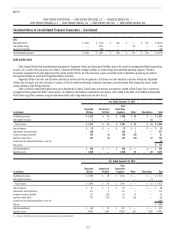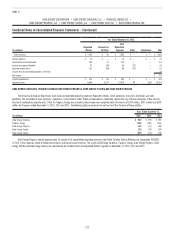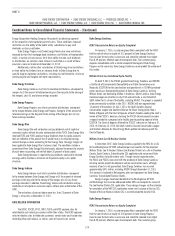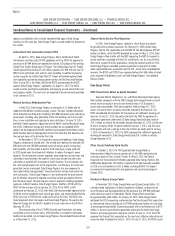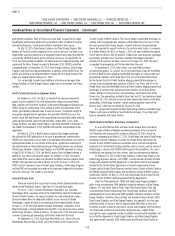Duke Energy 2015 Annual Report Download - page 147
Download and view the complete annual report
Please find page 147 of the 2015 Duke Energy annual report below. You can navigate through the pages in the report by either clicking on the pages listed below, or by using the keyword search tool below to find specific information within the annual report.
127
PART II
DUKE ENERGY CORPORATION • DUKE ENERGY CAROLINAS, LLC • PROGRESS ENERGY, INC. •
DUKE ENERGY PROGRESS, LLC • DUKE ENERGY FLORIDA, LLC • DUKE ENERGY OHIO, INC. • DUKE ENERGY INDIANA, INC.
Combined Notes to Consolidated Financial Statements – (Continued)
On January 28, 2014, Duke Energy Florida terminated the Levy
engineering, procurement and construction agreement (EPC). Duke Energy
Florida may be required to pay for work performed under the EPC and to bring
existing work to an orderly conclusion, including but not limited to costs to
demobilize and cancel certain equipment and material orders placed. Duke
Energy Florida recorded an exit obligation of $25 million in first quarter 2014 for
the termination of the EPC. This liability was recorded within Other in Deferred
Credits and Other Liabilities with an offset primarily to Regulatory assets on
the Consolidated Balance Sheets. Duke Energy Florida is allowed to recover
reasonable and prudent EPC cancellation costs from its retail customers.
The 2012 Settlement provided that Duke Energy Florida include the
allocated wholesale cost of Levy as a retail regulatory asset and include this
asset as a component of rate base and amortization expense for regulatory
reporting. In accordance with the 2013 Settlement, Duke Energy Florida ceased
amortization of the wholesale allocation of Levy investments against retail rates.
In the second quarter of 2013, Duke Energy Florida recorded a pretax charge of
$65 million to write off the wholesale portion of Levy investments. This amount
is included in Impairment charges on Duke Energy Florida’s Statements of
Operations and Comprehensive Income.
On October 27, 2014, the FPSC approved Duke Energy Florida rates for
2015 for Levy as filed and consistent with those established in the 2013 Revised
and Restated Settlement Agreement. Recovery of the remaining retail portion
of the project costs may occur over five years from 2013 through 2017. Duke
Energy Florida has an ongoing responsibility to demonstrate prudency related
to the wind down of the Levy investment and the potential for salvage of Levy
assets. As of December 31, 2015, Duke Energy Florida has a net uncollected
investment in Levy of approximately $183 million, including AFUDC. Of this
amount, $105 million related to land and the COL is included in Net, property,
plant and equipment and will be recovered through base rates and $78 million
is included in Regulatory assets within Regulatory Assets and Deferred Debits on
the Consolidated Balance Sheets and will be recovered through the NCRC.
On April 16, 2015, the FPSC approved Duke Energy Florida’s petition to
cease collection of the Levy Nuclear Project fixed charge beginning with the first
billing cycle in May 2015. On August 18, 2015, the FPSC approved leaving the
Levy Nuclear Project portion of the Nuclear Cost Recovery Clause charge at zero
dollars for 2016 and 2017, consistent with the 2013 Settlement. Duke Energy
Florida will submit by May 2017 a true-up of Levy Nuclear Project costs or
credits to be recovered no earlier than January 2018. To the extent costs become
known after May 2017, Duke Energy Florida will petition for recovery at that time.
Crystal River 1 and 2 Coal Units
Duke Energy Florida has evaluated Crystal River 1 and 2 coal units for
retirement in order to comply with certain environmental regulations. Based on
this evaluation, those units will likely be retired by 2018. Once those units are
retired Duke Energy Florida will continue recovery of existing annual depreciation
expense through the end of 2020. Beginning in 2021, Duke Energy Florida will
be allowed to recover any remaining net book value of the assets from retail
customers through the Capacity Cost Recovery Clause. In April 2014, the FPSC
approved Duke Energy Florida’s petition to allow for the recovery of prudently
incurred costs to comply with the Mercury and Air Toxics Standard through the
Environmental Cost Recovery Clause.
Cost of Removal Reserve
The 2012 Settlement and the 2013 Settlement provide Duke Energy
Florida the discretion to reduce cost of removal amortization expense for a
certain portion of the cost of removal reserve until the earlier of its applicable
cost of removal reserve reaches zero or the expiration of the 2013 Settlement.
Duke Energy Florida could not reduce amortization expense if the reduction
would cause it to exceed the appropriate high point of the return on equity
range. Duke Energy Florida recognized a reduction in amortization expense of
$114 million for the year ended December 31, 2013. Duke Energy Florida had
no cost of removal reserves eligible for amortization to income remaining after
December 31, 2013.
Duke Energy Ohio
Accelerated Natural Gas Service Line Replacement Rider
On January 20, 2015, Duke Energy Ohio filed an application for approval
of an accelerated natural gas service line replacement program (ASRP). The
ASRP is modeled after the accelerated main replacement program (AMRP),
which concluded on December 31, 2015. Under the ASRP, Duke Energy Ohio
proposes to replace certain natural gas service lines on an accelerated basis.
The program is proposed to last 10 years. Through the ASRP, Duke Energy Ohio
also proposes to complete preliminary survey and investigation work related
to natural gas service lines that are customer-owned and for which it does
not have valid records and, further, to relocate interior natural gas meters to
suitable exterior locations where such relocation can be accomplished. Duke
Energy Ohio projects total capital and operations and maintenance expenditures
under the ASRP to approximate $320 million. The filing also seeks approval of
Rider ASRP, the rider through which expenditures would be recovered. Similar to
the Rider AMRP methodology, Duke Energy Ohio proposes to update Rider ASRP
on an annual basis. Duke Energy Ohio’s application is pending before the PUCO
and it is uncertain when an order will be issued.
Intervenors oppose the ASRP, primarily because they believe the program
is neither required nor necessary under federal pipeline regulation. The hearing
concluded on November 19, 2015 and initial and reply briefs were filed, with
briefing complete on December 23, 2015.
Duke Energy Ohio cannot predict the outcome of this matter.
Energy Efficiency Cost Recovery
On March 28, 2014, Duke Energy Ohio filed an application for recovery
of program costs, lost distribution revenue and performance incentives related
to its energy efficiency and peak demand reduction programs. These programs
are undertaken to comply with environmental mandates set forth in Ohio law.
After a comment period, the PUCO approved Duke Energy Ohio’s application, but
found that Duke Energy Ohio was not permitted to use banked energy savings
from previous years in order to calculate the amount of allowed incentive. This
conclusion represented a change to the cost recovery mechanism that had
been agreed to by intervenors and approved by the PUCO in previous cases.
As a result of the PUCO’s decision, Duke Energy Ohio reversed $23 million in
revenues deemed to be refundable for the period between January 2013 and
April 2015 in second quarter 2015. The PUCO granted Duke Energy Ohio’s
application for rehearing on July 8, 2015. Substantive ruling on the application
for rehearing is pending. The PUCO granted all applications for rehearing for
future consideration. On January 6, 2016, Duke Energy Ohio and PUCO Staff
entered into a stipulation, pending PUCO approval, resolving the issues related
to, among other things, performance incentives and the PUCO Staff audit of
2013 costs. Based on this stipulation, in December 2015, Duke Energy Ohio re-
established approximately $20 million of the revenues that had been reversed
in the second quarter. A hearing on the stipulation is scheduled for March 10,
2016. Duke Energy Ohio cannot predict the outcome of this matter.




